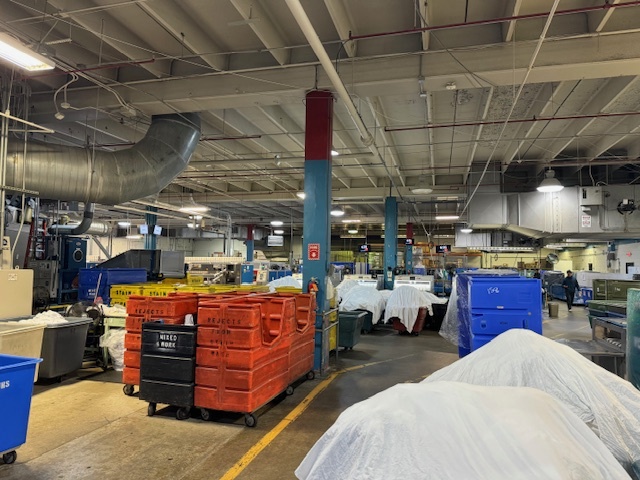Commercial Laundry Quality Control Best Practices


The concept of “quality” is something everyone can understand: we all want a good product.
Whether you’re eating at a restaurant or buying a new shirt, we all want quality.
But quality isn’t something that just happens passively: it takes work.
Operations that produce quality products typically have a strong quality control process in place behind the scenes. There’s no doubt about it, it can be a tough job, one of those functions that only gets noticed when something slips through the cracks.
That is why having an effective quality control plan is vital toward mitigating those slip-ups, as there’s a big difference between the occasional substandard product and a consistent problem that can cost you time, money and reputational damage.
In this article, we’ll review a few basics about:
- How quality control works in a commercial laundry plant
- Why it matters
- What you can do to improve quality in your plant
How Commercial Laundry Quality Control Works
At its core, quality control in a laundry facility is about identifying and removing unusable or unsightly items—those with stains, holes, or tears—before they reach the customer.
Traditionally, the industry accepts a 3–5% reject rate, meaning that only a small fraction of washed items can have defects before performance is considered unacceptable.
Quality issues are typically spotted during finishing. Operators conduct quick visual inspections as they handle linens—whether folding manually or feeding them into machines. In some plants, machines feature "reject" or "stain" buttons that direct faulty items into separate bins.
Some facilities supplement operator-level QC with formal programs, assigning a staff member to randomly inspect finished product packages. If defect rates exceed internal thresholds, the plant investigates and corrects the underlying issues. This check-and-balance approach—combined with operator inspections—forms the foundation of most quality control frameworks.
Even plant cleanliness contributes: linens dropped on dusty concrete floors can pick up hard-to-remove stains, highlighting how seemingly minor operational lapses can degrade product quality.
Commercial Laundry Quality Control Metrics and Standards
Several quantitative metrics drive quality control in commercial laundries:
Stain and Rewash Rate: This reflects the proportion of items rejected for stains and sent through specialized stain-wash cycles. Plants can calculate this by comparing stain-wash poundage against total wash volume. A healthy target is generally around 3%.
Rag-Out Rate: This tracks items that are torn or otherwise unusable. Plants either weigh discarded goods or manually tally damaged items to monitor trends.
Soil Factor: This is the difference in weight between incoming soiled linens and outgoing clean ones, adjusted for moisture content. Target thresholds vary by industry:
- Hospitality: ~8%
- Healthcare: 8–12%
- Food & Beverage: ~15%
- Industrial: 8–14%
Customer Complaint Volume: Voice-of-customer data is vital. A spike in complaints about stained or torn items is a clear signal that quality controls need review.
Each plant must tailor its metrics to match customer expectations. For example, a luxury hotel may demand perfectly pressed, stain-free linens, while a casual dining venue might tolerate a few minor imperfections. Regional norms and customer segments heavily influence what’s deemed acceptable.
Bottom line, you need to be aligned with customer expectations.
Commercial Laundry QC Best Practices
For many plants, improving quality control doesn't require adding full-time QC staff—especially in an era of labor shortages.
Instead, the focus should be on systematizing QC responsibilities and embedding them into everyday workflows.
-
Create Clear SOPs
Standard operating procedures (SOPs) are foundational. They should clearly outline what qualifies as a reject, where defective items go, and how operators are expected to respond. SOPs should be visually accessible—e.g., posters showing good vs. bad examples near workstations. Just like clarity of communication is critical when, for example, reviewing KPIs with employees, it's also important for your staff to have a clear understanding of how to identify rejects and what to do with them once they’ve been identified.
Overall, as a plant manager, your goal should be to eliminate as much uncertainty as possible in the flow of operations. Having clearly outlines SOPs is the first way to do that when it comes to bolstering quality control.
-
Integrate QC into Operator Standards
Operators must be allowed and expected to perform quick quality assessments as they process each item. Crucially, this time must be factored into their production standards. If production expectations are too aggressive, quality inevitably suffers.
-
Match QC Rigor to Market Demands
Over-engineering quality checks can be as costly as neglecting them. Each plant must find the right balance between labor cost and quality expectations. Aligning quality assurance investments with what customers value most ensures efficiency and satisfaction.
-
Use Data to Identify Gaps
Systems like Spindle can help automate data collection and analysis, giving managers visibility into trends like rising rewash rates or labor inefficiencies. These insights enable timely interventions without relying solely on manual QC checks.
Data can be your biggest ally in helping you see the big picture in terms of quality trends in your plant ... so use it!
Your processes, equipment and employees are constantly telling stories via data, so make sure you're listening so you can be the one to write the next chapter of your plant's story rather than leaving it up to fate.
-
Invest in Smart Technology
Emerging vision systems use cameras to detect stains and imperfections on linens before finishing. As these technologies mature and become more affordable, they’ll play a larger role in enabling real-time, automated quality checks.
-
Don’t Ignore the Hidden Costs
Poor quality control leads to excessive rewashes, wasted labor, increased water and energy usage, and the premature replacement of linens. One real-world example involved a plant that lacked proper stain-wash handling. After several inefficient rewashes and poor sensor calibration, the plant faced a 25% difference between soil received and product delivered—far above the 10% target. Once they addressed the issue, they saved approximately $750,000 annually in utilities, labor, and replacement costs. That’s obviously a significant number, and while your hidden costs might not be quite that high, odds are there is money that you could be saving with better quality procedures in place.
In Summary ... Quality Control is Vital
Quality control is not a luxury or an added bonus on top of otherwise solid operational processes.
Quality control is the sometimes overlooked element that helps make good operations great and can uplift lower-performing ones if enough time and dedication is devoted to it.
With the right metrics, procedures, and expectations in place, any laundry operation can elevate its product standards while controlling costs.
Todd Leeth, Spindle director of sales, emphasizes that every plant, no matter how small, should have something when it comes to quality control — a written program, employee training, and routine inspections — because doing nothing simply isn’t an option.
While lax quality control might not hurt your plant today, it very well could down the line in the form of customer complaints and even lost business if quality is a chronic problem.
Fortunately, with the above examples as starting points, quality is something you can have a real impact on, in some cases without taking on added costs.
Interested in learning more? Reach out to chat with a Spindle representative to request a demo and see how Spindle, laundry's connected platform, can help you boost your quality control regimen.

